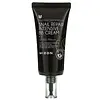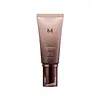What's inside
What's inside
 Key Ingredients
Key Ingredients

 Benefits
Benefits

 Concerns
Concerns

 Ingredients Side-by-side
Ingredients Side-by-side

Snail Secretion Filtrate
Skin ConditioningEthylhexyl Methoxycinnamate
UV AbsorberTitanium Dioxide
Cosmetic ColorantPolymethyl Methacrylate
PEG/PPG-17/6 Copolymer
SolventDicaprylyl Carbonate
EmollientDimethicone
EmollientCetyl PEG/PPG-10/1 Dimethicone
EmulsifyingArbutin
AntioxidantBis-Ethylhexyloxyphenol Methoxyphenyl Triazine
Skin ConditioningSodium Chloride
MaskingOzokerite
Emulsion StabilisingCyclopentasiloxane
EmollientTriethyl Citrate
MaskingDisteardimonium Hectorite
StabilisingC12-15 Alkyl Benzoate
AntimicrobialGlycosyl Trehalose
Emulsion StabilisingHydrogenated Starch Hydrolysate
HumectantCalcium Stearate
Cosmetic ColorantHexyl Laurate
EmollientZinc Oxide
Cosmetic ColorantSorbitan Sesquioleate
EmulsifyingSodium Hyaluronate
HumectantLauryl PEG/PPG-18/18 Methicone
Skin ConditioningPolyhydroxystearic Acid
EmulsifyingAlumina
AbrasiveAluminum Stearate
Cosmetic ColorantAllantoin
Skin ConditioningPanthenol
Skin ConditioningTriethoxycaprylylsilane
Beta-Glucan
Skin ConditioningAdenosine
Skin ConditioningLecithin
EmollientTocopheryl Acetate
AntioxidantCaprylic/Capric Triglyceride
MaskingUbiquinone
AntioxidantDiisopropyl Adipate
EmollientGlycerin
HumectantArnica Montana Flower Extract
MaskingArtemisia Absinthium Extract
Skin ConditioningAchillea Millefolium Extract
CleansingGentiana Lutea Root Extract
Skin ConditioningAlcohol Denat.
AntimicrobialCastanea Sativa Seed Extract
Skin ConditioningCarica Papaya Fruit Extract
Skin ConditioningLavandula Angustifolia Extract
Skin ConditioningCornus Officinalis Fruit Extract
Skin ConditioningOctanediol
Ethylhexylglycerin
Skin ConditioningTropolone
Skin ConditioningDisodium EDTA
Parfum
MaskingCI 77491
Cosmetic ColorantCI 77492
Cosmetic ColorantCI 77499
Cosmetic ColorantSnail Secretion Filtrate, Ethylhexyl Methoxycinnamate, Titanium Dioxide, Polymethyl Methacrylate, PEG/PPG-17/6 Copolymer, Dicaprylyl Carbonate, Dimethicone, Cetyl PEG/PPG-10/1 Dimethicone, Arbutin, Bis-Ethylhexyloxyphenol Methoxyphenyl Triazine, Sodium Chloride, Ozokerite, Cyclopentasiloxane, Triethyl Citrate, Disteardimonium Hectorite, C12-15 Alkyl Benzoate, Glycosyl Trehalose, Hydrogenated Starch Hydrolysate, Calcium Stearate, Hexyl Laurate, Zinc Oxide, Sorbitan Sesquioleate, Sodium Hyaluronate, Lauryl PEG/PPG-18/18 Methicone, Polyhydroxystearic Acid, Alumina, Aluminum Stearate, Allantoin, Panthenol, Triethoxycaprylylsilane, Beta-Glucan, Adenosine, Lecithin, Tocopheryl Acetate, Caprylic/Capric Triglyceride, Ubiquinone, Diisopropyl Adipate, Glycerin, Arnica Montana Flower Extract, Artemisia Absinthium Extract, Achillea Millefolium Extract, Gentiana Lutea Root Extract, Alcohol Denat., Castanea Sativa Seed Extract, Carica Papaya Fruit Extract, Lavandula Angustifolia Extract, Cornus Officinalis Fruit Extract, Octanediol, Ethylhexylglycerin, Tropolone, Disodium EDTA, Parfum, CI 77491, CI 77492, CI 77499
Water
Skin ConditioningCI 77891
Cosmetic ColorantCyclopentasiloxane
EmollientDipropylene Glycol
HumectantPanax Ginseng Root Extract
EmollientPhenyl Trimethicone
Skin ConditioningButyloctyl Salicylate
Skin ConditioningCetyl PEG/PPG-10/1 Dimethicone
EmulsifyingButylene Glycol
HumectantCyclohexasiloxane
EmollientNiacinamide
SmoothingTalc
AbrasiveCalcium Stearate
Cosmetic ColorantMagnesium Sulfate
Sorbitan Sesquioleate
EmulsifyingCI 77492
Cosmetic ColorantTocopheryl Acetate
AntioxidantDimethicone
EmollientSynthetic Beeswax
Emulsion StabilisingAluminum Hydroxide
EmollientHydrogenated Polyisobutene
EmollientStearic Acid
CleansingPhenoxyethanol
PreservativeCaprylyl Glycol
EmollientCI 77491
Cosmetic ColorantGlycerin
HumectantTriethoxycaprylylsilane
Disteardimonium Hectorite
StabilisingCI 77499
Cosmetic ColorantSilica
AbrasiveAlcohol
Antimicrobial1,2-Hexanediol
Skin ConditioningDisodium EDTA
Triethyl Citrate
MaskingHydroxyethylcellulose
Emulsion StabilisingAdenosine
Skin ConditioningParfum
MaskingDimethicone Crosspolymer
Emulsion StabilisingEthylhexylglycerin
Skin ConditioningBeeswax
Emulsion StabilisingDimethicone/Vinyl Dimethicone Crosspolymer
Skin ConditioningCellulose
AbsorbentSodium Hyaluronate
HumectantPolymethylsilsesquioxane
CI 77480
Cosmetic ColorantBifida Ferment Lysate
Skin ConditioningCentella Asiatica Extract
CleansingLactose
HumectantSilica Silylate
EmollientPanthenol
Skin ConditioningDisodium Stearoyl Glutamate
CleansingDisodium Phosphate
BufferingPolysorbate 60
EmulsifyingMadecassoside
AntioxidantSodium Phosphate
BufferingButylphenyl Methylpropional
PerfumingBenzyl Benzoate
AntimicrobialWater, CI 77891, Cyclopentasiloxane, Dipropylene Glycol, Panax Ginseng Root Extract, Phenyl Trimethicone, Butyloctyl Salicylate, Cetyl PEG/PPG-10/1 Dimethicone, Butylene Glycol, Cyclohexasiloxane, Niacinamide, Talc, Calcium Stearate, Magnesium Sulfate, Sorbitan Sesquioleate, CI 77492, Tocopheryl Acetate, Dimethicone, Synthetic Beeswax, Aluminum Hydroxide, Hydrogenated Polyisobutene, Stearic Acid, Phenoxyethanol, Caprylyl Glycol, CI 77491, Glycerin, Triethoxycaprylylsilane, Disteardimonium Hectorite, CI 77499, Silica, Alcohol, 1,2-Hexanediol, Disodium EDTA, Triethyl Citrate, Hydroxyethylcellulose, Adenosine, Parfum, Dimethicone Crosspolymer, Ethylhexylglycerin, Beeswax, Dimethicone/Vinyl Dimethicone Crosspolymer, Cellulose, Sodium Hyaluronate, Polymethylsilsesquioxane, CI 77480, Bifida Ferment Lysate, Centella Asiatica Extract, Lactose, Silica Silylate, Panthenol, Disodium Stearoyl Glutamate, Disodium Phosphate, Polysorbate 60, Madecassoside, Sodium Phosphate, Butylphenyl Methylpropional, Benzyl Benzoate
 Reviews
Reviews

Ingredients Explained
These ingredients are found in both products.
Ingredients higher up in an ingredient list are typically present in a larger amount.
Adenosine is in every living organism. It is one of four components in nucleic acids that helps store our DNA.
Adenosine has many benefits when used. These benefits include hydrating the skin, smoothing skin, and reducing wrinkles. Once applied, adenosine increases collagen production. It also helps with improving firmness and tissue repair.
Studies have found adenosine may also help with wound healing.
In skincare products, Adenosine is usually derived from yeast.
Learn more about AdenosineWe don't have a description for Calcium Stearate yet.
This ingredient is a high molecular weight silicone. It has emulsifying and skin conditioning properties.
Ci 77491 is also hydrated iron III oxide. It's sole purpose is to give a red/pink hue to products.
Iron III oxides are classified as inorganic chemicals for coloring.
Synthetically created Ci 77491 is considered safer than those naturally found. This is because the synthetically created version may contain less impurities. Iron oxides are generally non-toxic and non-allergenic.
Learn more about CI 77491Ci 77492 is also hydrated iron III oxide. It's sole purpose is to give a yellow hue to products.
Iron III oxides are classified as inorganic chemicals for coloring.
Synthetically created Ci 77492 is considered safer than those naturally found. This is because the synthetically created version may contain less impurities. Iron oxides are generally non-toxic and non-allergenic.
Learn more about CI 77492Ci 77499 is also hydrated iron III oxide. It is created from mixing red and black iron oxides. This helps give shades of darkness to a product.
Iron III oxides are classified as inorganic chemicals for coloring.
Cyclopentasiloxane, or D5, is a silicone used to improve texture of products and trap moisture.
D5 is considered lightweight and volatile. Volatile means it evaporates quickly after application. Once evaporated, D5 leaves a thin barrier that helps keep skin hydrated.
It is also an emollient. Emollients help soften the skin and prevent water loss. Silicones create a silky texture in products. D5 helps other ingredients become more spreadable.
Studies show D5 is safe to use in skincare products. We recommend speaking with a skincare professional if you have concerns.
Learn more about CyclopentasiloxaneDimethicone is a type of synthetic silicone created from natural materials such as quartz.
What it does:
Dimethicone comes in different viscosities:
Depending on the viscosity, dimethicone has different properties.
Ingredients lists don't always show which type is used, so we recommend reaching out to the brand if you have questions about the viscosity.
This ingredient is unlikely to cause irritation because it does not get absorbed into skin. However, people with silicone allergies should be careful about using this ingredient.
Note: Dimethicone may contribute to pilling. This is because it is not oil or water soluble, so pilling may occur when layered with products. When mixed with heavy oils in a formula, the outcome is also quite greasy.
Learn more about DimethiconeDisodium EDTA plays a role in making products more stable by aiding other preservatives.
It is a chelating agent, meaning it neutralizes metal ions that may be found in a product.
Disodium EDTA is a salt of edetic acid and is found to be safe in cosmetic ingredients.
Learn more about Disodium EDTADisteardimonium Hectorite comes from the clay mineral named hectorite. It is used to add thickness to a product.
It can also help stabilize a product by helping to disperse other ingredients.
Hectorite is a rare, white clay mineral.
Learn more about Disteardimonium HectoriteEthylhexylglycerin (we can't pronounce this either) is commonly used as a preservative and skin softener. It is derived from glyceryl.
You might see Ethylhexylglycerin often paired with other preservatives such as phenoxyethanol. Ethylhexylglycerin has been found to increase the effectiveness of these other preservatives.
Glycerin is already naturally found in your skin. It helps moisturize and protect your skin.
A study from 2016 found glycerin to be more effective as a humectant than AHAs and hyaluronic acid.
As a humectant, it helps the skin stay hydrated by pulling moisture to your skin. The low molecular weight of glycerin allows it to pull moisture into the deeper layers of your skin.
Hydrated skin improves your skin barrier; Your skin barrier helps protect against irritants and bacteria.
Glycerin has also been found to have antimicrobial and antiviral properties. Due to these properties, glycerin is often used in wound and burn treatments.
In cosmetics, glycerin is usually derived from plants such as soybean or palm. However, it can also be sourced from animals, such as tallow or animal fat.
This ingredient is organic, colorless, odorless, and non-toxic.
Glycerin is the name for this ingredient in American English. British English uses Glycerol/Glycerine.
Learn more about GlycerinPanthenol is a common ingredient that helps hydrate and soothe the skin. It is found naturally in our skin and hair.
There are two forms of panthenol: D and L.
D-panthenol is also known as dexpanthenol. Most cosmetics use dexpanthenol or a mixture of D and L-panthenol.
Panthenol is famous due to its ability to go deeper into the skin's layers. Using this ingredient has numerous pros (and no cons):
Like hyaluronic acid, panthenol is a humectant. Humectants are able to bind and hold large amounts of water to keep skin hydrated.
This ingredient works well for wound healing. It works by increasing tissue in the wound and helps close open wounds.
Once oxidized, panthenol converts to pantothenic acid. Panthothenic acid is found in all living cells.
This ingredient is also referred to as pro-vitamin B5.
Learn more about PanthenolParfum is a catch-all term for an ingredient or more that is used to give a scent to products.
Also called "fragrance", this ingredient can be a blend of hundreds of chemicals or plant oils. This means every product with "fragrance" or "parfum" in the ingredients list is a different mixture.
For instance, Habanolide is a proprietary trade name for a specific aroma chemical. When used as a fragrance ingredient in cosmetics, most aroma chemicals fall under the broad labeling category of “FRAGRANCE” or “PARFUM” according to EU and US regulations.
The term 'parfum' or 'fragrance' is not regulated in many countries. In many cases, it is up to the brand to define this term.
For instance, many brands choose to label themselves as "fragrance-free" because they are not using synthetic fragrances. However, their products may still contain ingredients such as essential oils that are considered a fragrance by INCI standards.
One example is Calendula flower extract. Calendula is an essential oil that still imparts a scent or 'fragrance'.
Depending on the blend, the ingredients in the mixture can cause allergies and sensitivities on the skin. Some ingredients that are known EU allergens include linalool and citronellol.
Parfum can also be used to mask or cover an unpleasant scent.
The bottom line is: not all fragrances/parfum/ingredients are created equally. If you are worried about fragrances, we recommend taking a closer look at an ingredient. And of course, we always recommend speaking with a professional.
Learn more about ParfumSodium Hyaluronate is hyaluronic acid's salt form. It is commonly derived from the sodium salt of hyaluronic acid.
Like hyaluronic acid, it is great at holding water and acts as a humectant. This makes it a great skin hydrating ingredient.
Sodium Hyaluronate is naturally occurring in our bodies and is mostly found in eye fluid and joints.
These are some other common types of Hyaluronic Acid:
Learn more about Sodium HyaluronateSorbitan Sesquioleate is derived from sorbitol and oleic acid. It is an emulsifier and prevents ingredients from separating.
Specifically, this ingredient is a water-in-oil emulsifier, meaning it helps water dissolve into oil.
Some studies suggest this ingredient may cause irritation in some people. If you are unsure, it is best to patch test.
This ingredient may not be Malassezia folliculitis, or fungal-acne safe.
Learn more about Sorbitan SesquioleateTocopheryl Acetate is AKA Vitamin E. It is an antioxidant and protects your skin from free radicals. Free radicals damage the skin by breaking down collagen.
One study found using Tocopheryl Acetate with Vitamin C decreased the number of sunburned cells.
Tocopheryl Acetate is commonly found in both skincare and dietary supplements.
Learn more about Tocopheryl AcetateTriethoxycaprylylsilane is a silicone used to bind and stabilize ingredients.
As an emulsifier, it helps prevent ingredients from separating. This can help elongate the shelf life of products.
Triethoxycaprylylsilane is often used to coat mineral sunscreens ingredients to help give a better feel. It also helps reduce oxidative stress in sunscreens.
Learn more about TriethoxycaprylylsilaneTriethyl Citrate comes from citric acid. It has masking, perfuming, and solvent properties. As a solvent, this ingredient helps disperse ingredients evenly in skincare.
One manufacturer claims this ingredient can:
According to perfume manufacturers, this ingredient is almost odorless but has a mild fruity, wine and plum scent. It can be used to mask the scent of other ingredients.
This ingredient can be plant-sourced or synthetic; it can naturally be found in cabbage and white wine.
Learn more about Triethyl Citrate